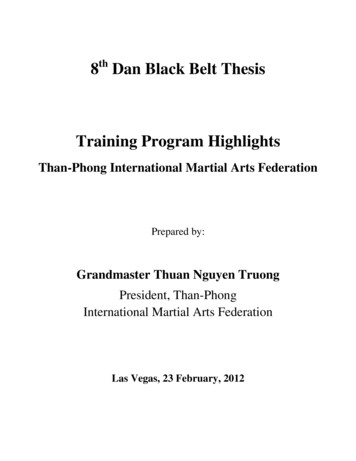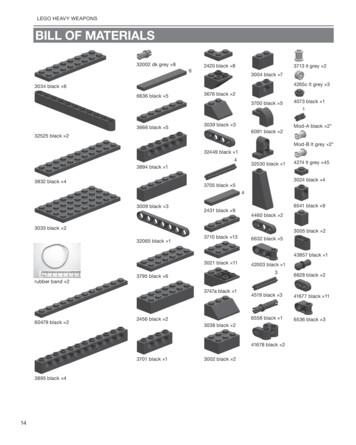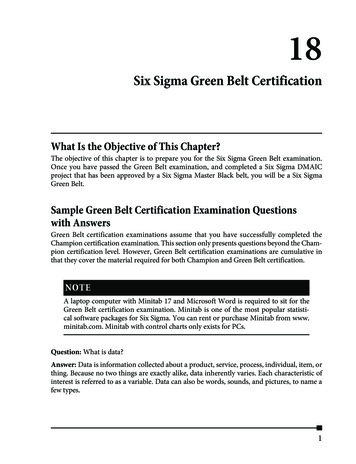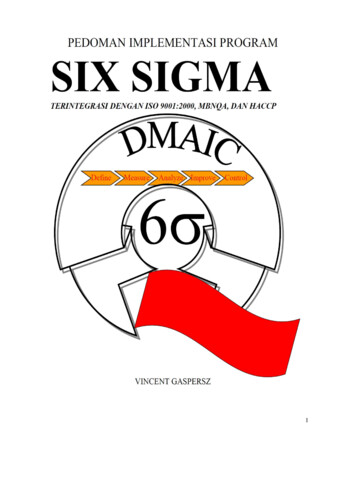
Transcription
8th Dan Black Belt ThesisTraining Program HighlightsThan-Phong International Martial Arts FederationPrepared by:Grandmaster Thuan Nguyen TruongPresident, Than-PhongInternational Martial Arts FederationLas Vegas, 23 February, 2012
Table of ContentsTable of Contents . 1Autobiography . 2Brief History of Than-Phong Martial Arts Academy . 3Than-Phong Achievements . 3Missions of Than-Phong Martial Arts Academy . 4Korean Masters at Than-Phong Martial Arts Academy . 4Than-Phong Training Program . . 4Than-Phong Taekwondo Belts System 5Seminars . 5Typical Class Activity . 6The Tenets of Taekwondo . 6The Student Oath . 7Samples of Black Belt Written Tests . . 7History of Taekwondo . 9Taekwondo Today . 9Moral Culture of Taekwondo 11The “Yin and Yang” Theory of Taekwondo . 11Breathing Method . 12Dan-Jun Breathing . 12Dan-Jun Breathing and Meditation 12Dan-Jun Breathing and Martial Arts Techniques . 13Dan-Jun Breathing and Breaking . 13Dan-Jun Breathing and Free Sparring . 14Summary of Dan-Jun Breathing 14Conclusion . 148th Dan Black Belt Thesis, by GM Thuan Nguyen Truong1
AutobiographyI was born into a traditional martial arts family. In my family, martial arts were taught to all menfrom generations to generations. According to the Truong’s Genealogy, my ancestors came fromHa Tinh province, north of Viet Nam, and settled in My Khe, Quang Ngai province, central ofViet Nam, in the early 15th century. Several generations had served several Kingdoms of VietNam. My great-great-grandfather, Truong Dang Que, a descendant of the seventh-generation,served through three Nguyen Dynasties (Minh Mang, Thieu Tri and Tu Duc) with high rankingsequivalent to the Prime Minister nowadays and also served as the King Tu Duc’s teacher.I am a descendant of the eleventh generation and the third child of a large family of ninechildren. My father began teaching the family traditional martial arts skills to his sons when theywere 4 years of age. He told us, “Boys have to learn martial arts for self-defense and to help thecommunity and the nation when needed.” Besides going to school and helping around the house,the boys would practice martial arts faithfully every night. My two older brothers were extremelywell trained. They would take turns to teach me when my father was busy. My father made a bigbanner and hung it in the middle of the family room with the words, “A healthy body begets asharp mind.” We grew up with the wisdom and infinite love of our parents and the everlastingsupport among our siblings.When I was 10 years of age, a close friend of my father, Sifu Tran Bang Tuong, who had aNorthern Shaolin Kungfu studio and the best Shaolin Kungfu Sifu locally, asked my father togive me permission to practice with him at his studio. My father was flattered and humblyagreed. Sifu Tran was very pleased with my progress and thus taught me various advancedtechniques. I then relocated to larger cities to pursue my high school and college education andcontinued to practice martial arts regularly. In Saigon (capital of South Viet Nam), at the referraland recommendation of Sifu Tran, I joined one of the most famous Northern Shaolin schools inthe Phu Nhuan District taught by one of the best Shaolin Kungfu at the time, Sifu Le Dai Hoan.Fortunately, Sifu Le recognized my skills and potentials early on and taught me a lot of hispersonal skills and trades and continually registered me to participate in local, regional andnational tournaments. Sifu Le always reminded me to practice diligently to “win with glory butlose with honor.” Under the outstanding guidance and exceptional teachings of Sifu Le, I wonnumerous tournaments and awards.During my third year of college, as the Civil War situation in Viet Nam became dreadful, I feltresponsible to serve my country and voluntarily joined the Viet Nam Air Force and became aPilot Officer. During this time, I decided to enroll in Than-Phong Taekwondo Academy offeredat the Air Force base hoping to learn a different style to enhance my martial arts skills. However,the more I practiced Taekwondo, the more I found many advantages in the methods of training,which were simple yet scientific. I began to research and study the philosophy of Taekwondo.8th Dan Black Belt Thesis, by GM Thuan Nguyen Truong2
The philosophy of Taekwondo revolves around the teaching of Courtesy, Integrity, Perseverance,Humility, Self-control, and Indomitable Spirit. I found it very similar to the teaching ofConfucianism, which Viet Nam and my upbringing were heavily influenced by. My father andmy Sifu’s often reminded me: “Be proud but humble. Use martial arts only in self-defense, tocontrol your actions and your mind, to help the weak, and to defend against injustice.”Brief History of Than-Phong Martial Arts AcademyLate Air Force General Luu Kim Cuong founded Than-Phong Martial Arts Academy in 1966,and made it one of the priority programs of the Division of Air Force Training. Martial Arts,consisting of Taekwondo, Aikido, Judo, Jujitsu, and Shaolin Kungfu, were taught to Air ForceOfficers, personnel and their families. The Korean Armed Force had an important role incontributing and developing Than-Phong Taekwondo Academy from 1966 to 1973 during thetime they based in South Viet Nam. The system of Than-Phong developed two civilian dojos:one located in the premises of the Civil Aviation of Tan Son Nhat Airport (1971), and the otherin the 4th District of Saigon (1972). The number of Than-Phong practitioners amounted toseveral tens of thousands. In April 1975, when South Viet Nam fell to Communist, all ThanPhong studios had to close down and cease operations.After April 1975, several Than-Phong Masters settled in the United States and the first ThanPhong studio was established in San Antonio, Texas. Eventually, a number of Than-Phongstudios were set up in various cities nationwide, including Hayward, Orange County, San Jose,Santa Clara, Oakland, San Diego, Houston, Virginia, Michigan, Seattle, and Florida. In 1992,Than-Phong went international to Australia, France, Switzerland, and Canada. In 1994, the firstThan-Phong school was established in Hanoi (North Viet Nam). In 2008, the CommunistRegime in Viet Nam officially allowed Than-Phong to re-operate in Saigon. The Than-Phongsystem is now knows as Than-Phong International Martial Arts Federation, of which I serve asPresident since 2009.Than-Phong AchievementsUnder the dedicated guidance of many renowned Korean Masters, Than-Phong Taekwondo waswidely known and quickly made a big name among all Vietnamese Taekwondo systems withmany glorious victories in many individual and team competitions (Black Belt and Brown Belt).Than-Phong achievements included:-1969, 1970, 1971, and 1973 (no participation in 1972), at the Annual National TaekwondoChampionship and the Annual Vietnam Armed Force Taekwondo Championship (alternatelyeach year): four Grand Champions in the Team competitions, numerous gold medals in the8th Dan Black Belt Thesis, by GM Thuan Nguyen Truong3
-Individual competitions, and two National Champion Flags Awards awarded by the KoreanArmed Force.1971, at the Second SEA Games in Malaysia: gold medal in the Team competition, gold andsilver medals in Individual Black Belt competitions, and bronze medal in Breaking.Missions of Than-Phong Martial Arts Academy1. Before the fall of South Viet Nam, before April 1975: “The mission of Than-Phong Academywas to build an elite team, well trained in all facets of physical and mental fitness, and moraleducation to uphold the spirit of ‘Brotherhood of solidarity to the service of the homeland.”2. After the fall of South Viet Nam, after April 1975, Than-Phong practitioners were scatteredall over the world. Some of the ex-Than-Phong instructors and I started to rebuild the systemwith a new mission statement: “To provide the highest teaching quality by implementing andutilizing martial arts tradition, expertise, and the culmination of the knowledge of ThanPhong Grandmasters and Masters from around the world who value and train in traditionalmartial arts in order to bring the mind, the body, and the spirit together.The quality of Than-Phong schools and instructors comes from the inheritance, fromgeneration to generation, of the excellent practice of traditional martial arts, which teachesproper self-defense and personal fitness, and instills in the student the maturity, discipline,balance and strength required to be a highly successful and strong person both inTaekwondo and in life.Korean Masters at Than-Phong Martial Arts AcademyIn 1966, President Pak Chung Hi of the Republic of Korea, assigned and sent Master MajorKang Dong Kil to Viet Nam to help develop Taekwondo in Viet Nam and support Than-PhongAcademy in its early years. Many renowned Masters came from Korea to train Than-Phongdisciples, including Masters Chung Tae Kap (Chief of Staff of the Korean Army in Viet Nam),Lieutenant Colonel Kim Bong Sik, Major Lee Sha Un, Captain Kim Byung Woon, Captain ChoSun Taik, Sergeant Cho Hyung Ho, Sergeant Her Man, Sergeant Kang Ho, Sergeant Shu JungDo, Sergeant Lee Keun Tae, and Kim (BatMan) Than-Phong Training ProgramBefore 1982, Than-Phong Taekwondo followed the guidelines of the International TaekwondoFederation (ITF) training program. From 1982 to 1995, Than-Phong started a dual-systemtraining to include both World Taekwondo Federation (WTF) and ITF. However, the training8th Dan Black Belt Thesis, by GM Thuan Nguyen Truong4
became increasingly difficult for young children to keep up so Than-Phong decided to modify itstraining program and applied it since 1996:-Beginner to Red belt 2nd grade: Students practice WTF forms, techniques, and sparring.Black belt, Poom and Dan: Students practice both WTF and ITF forms (from Hwa-Rang andhigher) and learn weapons Nunchaku, Bo, and Knife.Than-Phong Taekwondo Belt SystemIn the first two years of its inception (1966-1967), Than-Phong recruited mostly famous fighters,instructors, or high ranking students from different martial arts systems in order to quicklydevelop and implement the Than-Phong program. At that time, Than-Phong introduced a simplesix-grade belt system which included White (beginner), Blue (5th), and Brown (4th to 1st). Afterthe second class of instructors in 1968, Than-Phong introduced an eight-grade belt system: White(beginner), Yellow (7th), Green (6th), Blue (5th), and Brown (4th to 1st). Since 1980, the ThanPhong system has changed to a ten-grade five colors and stripes belt system. Each colorrepresents two grades: White (10th & 9th), Yellow (8th & 7th), Green (6th & 5th), Blue (4th & 3rd),and Red (2nd & 1st).We design our own training curriculum for each level. Every three months of scheduled training,students will be allowed to test for the next level. All students will have to maintain his/heracademic grade level higher than 70% and no “U” in conduct. A student can skip a level ifhis/her performance is exceptional at the belt test as well as maintaining excellent academicmarks. Each student is required to know all the forms up to their grades. During their belt tests,students are to perform their grade level forms and draw and perform one lower belt form. Theyare also required to do five one-step basic techniques. Breaking and sparring start from theYellow belt 8th grade and up. At the Red belt level, students are introduced to basic weaponmovements for Bo and Nunchaku upon completing a basic weapon seminar. Red belt 1st gradestudents are required to train on schedule for six months before they can apply to test for Blackbelt. All Black belt tests follow WTF rules and regulations.SeminarsWe teach seminars to prepare each Dan/Poom level before testing. For example:- Black Belt Preparation Seminar for Red belt 1st grade- Assistant Instructor Seminar for 1st Dan/Poom- Instructor Seminar for 2nd Dan/Poom- Director Seminar for 3rd Dan, 25 years of age or older- Leadership Seminar for all Black belt from 15 years of age and older. This encompassesleadership value as well as judge and referee training.8th Dan Black Belt Thesis, by GM Thuan Nguyen Truong5
Besides technical training, the Than-Phong system also includes the teaching of martial artsmorals and philosophy. We start each class by reciting the Tenets and Student Oath followed byfive minutes of meditation to review the students’ daily activities. During this time, we ask thestudents to recognize both the good and the bad things that have happened. We believe that if astudent is always aware of what he/she is doing, he/she will approach situations in a bettermanner.For Red belt testing and higher, we require our students to answer questions about the Tenets ofTaekwondo, the morals and philosophy of martial arts as well as the history of Taekwondo andof the history the Than-Phong system. Additionally, students must pass a physical endurancetest. Students run the football field track for at least 0.5 mile nonstop for beginners and add on atwo-lap increment with each grade. Running time requirements differ between children andadults.Typical Class Activity: 1.5 HoursSalutation and meditation (5 minutes): Recite the Tenets of Taekwondo and the StudentOath. Students sit down quietly in a meditation status.Warm-up Stretches (10 minutes): Stretch, sit-up, push-up, jumping jack, and punch.Warm-up Kicks (15 minutes): Kick bag, punch bag, jump rope, roll on mat.Basic Techniques (30 minutes): Practice forms required for each level.One-step, Semi-Sparring Techniques, Sparring (30 minutes):The Tenets of TaekwondoLễ NghĩaCourtesy: To be thoughtful and considerate of others. Taekwondo students and instructorsshould be polite, and show consideration for others.Liêm SĩIntegrity: To be honest and good. Taekwondo practitioners should live by a code of moralvalues and principles.Nhẫn NạiPerseverance: To never give up in the pursuit of one's goals. Students should welcomechallenges, because challenges help them grow and improve.겸손 Khiêm TốnHumility: a disposition to be humble; a lack of false pride.8th Dan Black Belt Thesis, by GM Thuan Nguyen Truong6
Khắc KỷSelf-Control: To have control of one’s body and mind. A Taekwondo student should alwayscontrol his actions and reactions.Tinh Thần Bất KhuấtIndomitable Spirit: To have courage in the face of adversity. A Taekwondo student shouldnever give up and always and highly maintain his/her spirit.The Student OathIn addition to the five tenets, there are also five principals of Than-Phong Taekwondo in whichwe encourage the students to fully understand and follow both inside and outside of the class.1.2.3.4.5.I shall be Loyal to my country.I shall Observe the Tenets of Taekwondo.I shall Respect my parents, masters, and seniors.I shall Uphold the Martial Arts spirit and sportsmanship.I shall Use Martial Arts for self-defense purpose only.Samples of Black Belt Written TestsFollowing are samples of Questions and Answers we prepared for Dan/Poom written tests:1. What are the 3 most important factors of Martial Arts?Speed, Balance, and Accuracy.2. How do you teach a beginner? Specifically, how do you plan for the first 3 months?Pay more attention and spend more time with the slow learners.Children: Need a lot of patience. Tone of voice must be soft but aggressive. Show and tellslowly. Make instructions easy to follow. Do not stay on one student too long. Alwayspraise their achievements.Adults: Respect, humble, sincere. Depending on who you are dealing with, do not go toofast or too slow. Praise and encourage often.Weeks 1-2: Familiarize students with all different warm up exercises. Weeks 3-4: Teachbasic stances (ready, forward, riding, block, punch on floor and bags). Weeks 5-8: TeachSaju and Kibon forms. Weeks 9-10: Teach 5 one-step techniques. Weeks 11-12: Reviewfor the first testing.3. How do you handle the class with multi-levels students?Need help and assistance from other instructors and advanced students.8th Dan Black Belt Thesis, by GM Thuan Nguyen Truong7
General exercises: Give clear and specific instructions on “how to.” Teach slowly and indetail. Pay more attention to new students. Get help from advanced students.Technical training: Keep practice continuous for all levels. Assign group leaders withclear direction. Teach each level enough to keep it going. Do not spend too much time onone student or a small group of students. Spend more time on weaker groups. Spend moretime on preparation for students who are scheduled to test.4. How do you describe the best technique?The best technique is a technique being executed timely with power and accuracy.5. What are the qualities of a Taekwondo instructor?Possess skills, knowledge, patience, and confidence. Be a leader and a role model. Beable to show and tell.6. What do you expect from practicing Taekwondo?Physical fitness and mental discipline.Prevent sickness, decrease chance of disease. Live a longer and healthier life.Confidence, be able to walk the walk and talk the talk. Courage. Clear mind. Relieve stress.7. What are the differences between color belt and black belt in Taekwondo besides the color?Color Belt is considered a novice level where students learn to lay a good foundation foradvanced levels, physically and mentally.Black Belt, technically, is considered as a beginner in the Taekwondo world. However, aBlack Belt holder is a leader, a role model, and a teacher.8. What are your commitments as a Black Belt holder?Stand for a better cause throughout life.Finish what you start.Practice the Tenets of Taekwondo daily and in any circumstance.9. What can Than-Phong expect from you as a student and as a Black Belt holder?Be a leader. Be a role model.Put extra effort in anything you do.Maintain good grades in school. Be always well disciplined.10. The application of forms in Martial Arts:A form includes all the basic techniques for sparring that are put together so they can beeasily remembered and more interesting to practice. Most of the moves are meaningfuland some moves are just a link between one technique to another.8th Dan Black Belt Thesis, by GM Thuan Nguyen Truong8
Practicing forms makes one aware of the direction and balance as well as improves powerand endurance.11. What are the advantages and disadvantages between low stance and high stance?Low stance: More balanced because the center of gravity is close to the ground. It alsomakes the legs and feet stronger. However, it is hard to move quickly.High stance: Easier to move around; therefore, it is useful during sparring for executingtechniques or dodging away from opponents attacks. Contrary to a low stance, thebalance with a high stance is very vulnerable.12. Than-Phong Logo, Uniform, Patch, and Belt SystemUniform: white V-neck uniform for all students from beginner to 2nd Kup Red Belt. RedBelt students have an option to wear a Red trim around the V-neck. All Black Beltstudents up to 6th Dan wear a Black trim V-neck uniform. Uniforms for students of 7thDan and higher include three 6-inch vertical black stripes on both sides of the shouldersand pants.All uniforms must have WTF Logo on the left of the chest and Than-Phong Yin YangLogo on the right. On the back is the Than-Phong Patch.Belts system: 10 Kup to 9th Dano Color Belts: from 10th to 1st with 5 colors: White, Yellow, Green, Blue, and Red.o Black Belts from 1st to 9th Dan are represented by the appropriate gold stripes.Seminars MaterialsFollowing are the main sections of the materials we use to teach in the seminars:History of TaekwondoEarly Koreans developed unique martial arts forms for unarmed self-defense to complement theirskills with weapons. The first recorded evidence of what was to become modern Taekwondo isfound about two thousand years ago in Korean history. A mural painting from the Koguryukingdom (37 B.C. to 66 A.D.) was found in a tomb believed to have been built sometime duringthe period 3 to 427 A.D. This mural depicts figures practicing martial arts techniques. Historicalrecords from this Koguryu period also mention the practice of martial arts techniques andtournaments. The early forms had different names, such as Kwonbak, Bakhi, Dangsoo, Taesooand Kongsoo From about 600 A.D. to about 1400, the mainstream dominant form was Soobak, which furtherevolved into Taekyon beginning in the late 1300s. Taekyon was the dominant Korean martialarts form until the Japanese invasion and occupation of Korea in 1909. From 1909 to 1945, the8th Dan Black Belt Thesis, by GM Thuan Nguyen Truong9
Japanese suppressed Korean culture and martial arts, and introduced the Japanese culture andmartial arts.The modern period of Taekwondo began with the defeat of the Japanese and the liberation ofKorea in 1945. Korean martial arts Masters wanted to eliminate Japanese influences. They begandiscussions on how to return to the traditional Taekyon based Korean martial arts and on how tounite the various martial arts schools (or Kwans) and styles into a single style and national sport.After several years of discussions, the name Taekwondo was chosen in April 1955 by the boardof Masters of the various Kwans, and the kwans started to unify through the late 1950s.Taekwondo TodayThe spread of Taekwondo as a martial art and competitive sport continues to this date. Today,Taekwondo is by far the most widely practiced martial art in the world. Especially, after it wasselected as a full Olympic sport for the 2000 Olympic Games in Sydney, Australia.The literal and superficial translation of Taekwondo is "the art (Do) of kicking (Tae) andpunching (Kwon). In the Korean language, “Do” implies the philosophical approach to a way oflife, a pathway to achieve enlightenment. The students of Taekwondo, through rigorous physicaltraining, intend to improve themselves physically, mentally, and spiritually.At the center of this philosophy, is the concept of interaction between opposing forces in nature(Ying vs. Yang). Equilibrium is only achieved when contrary forces are distributed in equalamounts, resulting in balance and harmony. When only one force dominates, however, the resultis imbalance, which could mean discord or failure.In today's society, there are relatively fewer chances to encounter a life-threatening situation thanwhen Taekwondo was first developed. Therefore, it is the spiritual part of Taekwondo thatmotivate people to become its practitioners. Some people practice Taekwondo simply for thefitness or because they want to train and excel in a sport. However, a true Taekwondopractitioner should never forget the importance of the philosophical, spiritual, and physicalaspects of Taekwondo to truly experience all of its benefits.Taekwondo is a scientific use of the body in methods of self-defense. It develops the body intoits ultimate use of its facilities through intensive physical and mental training. Taekwondo withits discipline, techniques, and mental training are the mortar for building a strong sense ofjustice, fortitude, humility, and resolve. It is this mental conditioning that makes a truepractitioner of martial arts. Taekwondo also teaches the importance of responsibility and honestyas the means to achieve harmony with society. A true Taekwondo student is the one who knows8th Dan Black Belt Thesis, by GM Thuan Nguyen Truong10
how to behave in any place and at any time and is trustworthy and sincere. This is the insigniafor which people would recognize the Taekwondo practitioner.There are many people who begin to study Taekwondo or other martial arts in order to learn selfdefense. Many parents bring their children to the dojo seeking helps to better the child’sdiscipline and focus. Children would benefit from Taekwondo as it helps them stay focused inschool, think quickly, get better grades and develop self-discipline and self-control. ButTaekwondo is a lot more than just that. Taekwondo practitioners have to memorize and live withits Tenets and to understand the philosophy behind it to become a better person, better life style.Respect, Humility, Integrity, and Self-control are the genuine qualities that all Taekwondostudents must possess. Although practicing Taekwondo elevates one’s self-confidence, oneshould not convey the false sense of superiority. On the contrary, all Taekwondo practitionersshould be humble and considerate and observe the highest regard for morality and ethics.The utmost purpose of Taekwondo is to eliminate fighting by discouraging the oppression of thestronger over the weaker with a power that must be based on humanity, justice, morality, wisdomand faith, thus helping to build a better and more peaceful world.The following philosophy and guidelines are the cornerstone of Taekwondo that all seriousstudents of this art are encouraged to live by.1. Be willing to go where the going may be tough and do the things that are worth doingeven though they are difficult.2. Be gentle to the weak and tough to the strong.3. Be content with what you have in money and position but never in skills.4. Always finish what you begin, be it large or small.5. Be a willing teacher to anyone regardless of religion, race or ideology.6. Never yield to repression or threat in the pursuit of a noble cause.7. Teach attitude and skill with action rather than words.8. Always be yourself even though your circumstances may change.9. Be the eternal teacher who teaches with the body when young, with words when old, andby moral precept even after death.Moral Culture of TaekwondoThe mental education of Taekwondo is aimed at enriching the noble character of each studentand at promoting good and healthy sportsmanship.The “Yin and Yang” Theory of TaekwondoAt the center of this philosophy is the concept of interaction between opposing forces in nature(Yin versus Yang). Equilibrium is only achieved when opposing forces are distributed in equalamounts, resulting in balance and harmony. When only one force dominates, however, the resultis imbalance, which could mean discord or failure. Under this concept, health is one consequence8th Dan Black Belt Thesis, by GM Thuan Nguyen Truong11
of the balance between the “Yin” and “Yang,” energy forces that rule the world. An imbalancebetween these two forces can result in illness. According to Taoism, the force of Yin and Yang isthe harmony between heaven and earth. The day (Yang) is followed by night (Yin) in perpetuity.Similarly, a person has a body (Yang) and a mind (Yin). The front side of the body is Yinwhereas the backside is Yang. Yin and Yang represent the dualism of the universe and can beseen as opposite ends of mutually complementary and interacting systems. Yin represents thepassive or negative female force (i.e., moon, earth, water, poverty, sadness) that produces cold,darkness, and emptiness. Yang is the active male force (i.e., sun, heaven, fire, goodness, wealth)and is reflected in warmth, light, and fullness. To be healthy, the individual must seek to balancethe force of Yin and Yang.Taekwondo builds on this “Yin and Yang” philosophy. Taekwondo training concentrates onphysical, mental, and spiritual balancing of left and right, hardness and softness, strength andweakness. Taekwondo is a complete sport that trains an individual to be physically, mentally,and spiritually fit.Breathing MethodMost people only use the top portion of their lung while breathing. They fail to fill the bottom aswell as the top portion of their lung. When you inhale, imagine the air fills your entire abdomenwith energy while concentrating on your Dan-Jun. When you exhale, imagine this energy travelsthrough your body while the air is being released through your nose.Dan-Jun BreathingBreathing is an essential and fundamental factor in Martial Arts. It has been used to developinternal power (Ki), self-confidence, concentration, and good health, which in itself lead to afruitful longevity.Dan-Jun in Korean means “Red Field,” “Hot Point,” or “Center of Energy.” It is pronounced“Tandem” in Japanese, “Dan Dien” in Vietnamese, and “Tantien” in Chinese. It refers to an arealocated two inches below the navel. This area is the center of gravity of the human body and, atthe same time, the seat of “Ki” (internal power of vital energy). Dan-Jun breathing is animportant martial arts exercise for the development of “Ki” that is used primarily for Meditationand for the Execution of Martial Arts Techniques.Dan-Jun Breathing and MeditationThere are many different breathing formulas while meditating. Inhaling and exhaling in all theformulas should be executed slowly. Some of the breathing formulas include:8th Dan Black Belt Thesis, by GM Thuan Nguyen Truong12
1.2.3.4.5.Inhale for 5 seconds and exhale for 5 secondsInhale for 5 seconds, hold 5 seconds, and exhale for 5 secondsInhale for 5 seconds, hold 5 seconds, exhale for 5 seconds, and hold 5 secondsInhale for 5 seconds, hold 10 seconds, exhale for 5 seconds, and hold 5 secondsInhale for 10 seconds, hold 15 seconds, exhale for 10 seconds, etc.The length of time you inhale, hold, and exhale can be gradually increased to the point that youcan remain idle for one minute or even longer. Choose one of the above breathing formulas andpractice it while meditating or performing Tai-Chi Chuan. As a result, you will increase your“Ki” and attain spiritual unification.Dan-Jun Breathing and Martial Arts TechniquesAnother method of practicing Dan-Jun breathing consists of inhali
Taekwondo and in life. Korean Masters at Than-Phong Martial Arts Academy In 1966, President Pak Chung Hi of the Republic of Korea, assigned and sent Master Major Kang Dong Kil to Viet Nam to help develop Taekwondo in Viet Nam and support Than-Phong Academy in its early years. Many renowned Masters came from Korea to train Than-Phong











